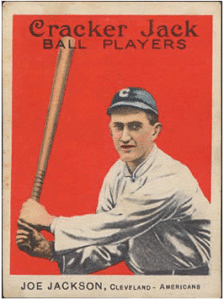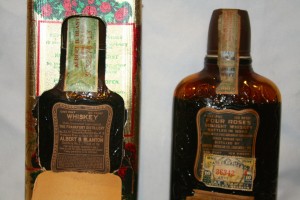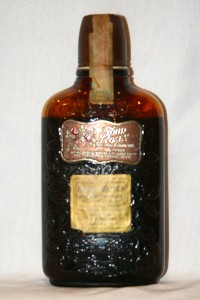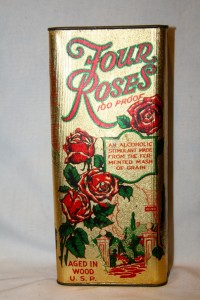
“Shoeless” Joe Jackson
As a relative newbie to the American whiskey scene, I am truly fascinated by the heritage of the brands, distilleries and those old pre-prohibition whiskey men (and women). I have a penchant for all things Americana and I love collecting artifacts that shaped who we are now as a nation. My original collecting sin was (and still is to a degree) vintage baseball cards for which I have deep admiration. My affection is not just for the cards but also for the game and its history. My favorite cardboard edition is the 1914 Cracker Jack set. The only way to get one of these cards was to purchase a box of the famous confectionery delight, fish around for the prize, and keep it for 100 years. And I don’t care if I never get back.

Same brand – different juice.
So, how do 1914 Cracker Jack baseball cards and Four Roses whiskey intersect? Your first thought might be Babe Ruth, but he isn’t the crux of this biscuit. It is a romantic connection I make on my own, which I hope you enjoy. You see, there is something about pre-prohibiton, pre-depression America that holds an innocent allure I find captivating. When I hold a 1914 Cracker Jack card that survived the grimy mitts of a crazed tween looking for their next sugar fix in one hand and an unopened pint of Four Roses Straight Whiskey that survived the crusty knuckles of a bulbous nosed tippler in the other, the g-spot in my mind gets suitably tickled. For those items to survive 100 years and be in my possession is like owning pieces of history. Now, on to the Whiskey Mystery.
Disclaimer: This post was written while snorkeling Four Roses Single Barrel hand picked by my local liquor store. Four Roses Warehouse GW, Barrel No. 37-2B, to be exact.
One oddity of Prohibition was the fact that tens of thousands of barrels of pre-pro hooch was still around from various distillers, both operating and defunct. Those barrels made their way to what were known as consolidation warehouses. The bloodlines of whiskey royalty were thrown into the equivalent of the Great American Melting Pot. Back then, whiskey was like a box of chocolates — you never knew what your were going to get. I’m sure not many people cared and were just happy to get some “Alcoholic Stimulant” that was aged in wood. A prime example of this is my pair of Four Roses Straight Whiskey pints.
Exhibit A: Four Roses Straight Whiskey. One Pint. Distilled by United American Co. Made Spring 1917 Bottled Fall 1934. As lore goes, we started running out of pre-pro whiskey and the government allowed distilling of new stuff for medicinal purposes around 1928. If that is the case, and I’m sure it is based on my research, this bottle is an anomaly. This whiskey sat around in a barrel from 1917 and didn’t get bottled until 1934, which is after Repeal. Yet another contradictory piece of evidence that makes me scratch my noggin. Nothing on this bottle says a thing about it being medicinal and the paper California tax stamp dated July 1, 1935 on the back is a dead giveaway this is a post-pro nugget. See the gallery below for close-ups.
Exhibit B: Four Roses Straight Whiskey. One Pint. Patented by The Frankfort Distillery. Produced by Col. Albert B. Blanton (yes, that Blanton) prior to Sept. 22, 1917, distillery No. 2, 7th district of Kentucky. Bottling date unknown unless I destroy the box and look at the tax stamp. Not. Gonna. Happen. If this were a box of unopened 1914 Cracker Jack with the potential of a Christy Mathewson in it would I open the cardboard coffer? Probably not. I’m weird like that. Anyway, this is medicinal whiskey and the box literally has it written all over it. This bottle seems to have the correct lineage in that The Frankfort Distillery, which was purchased by Paul Jones, produced Four Roses from the end of Prohibition until Seagram’s bought the distillery in 1941.
These bottles raise more questions than my research answers. First, if the Ex. B is the correct lineage but bottled during Prohibition, what is the Four Roses brand on Ex. A doing on a post-pro United American Co. Distillery bottle? If this were the opposite, I would understand, but its not. Secondly, if we were running out of whiskey in the late twenties, where did the Ex. A whiskey come from? Some hidden batch forgotten by time? Lastly, what does Albert Blanton have to do with Four Roses?
Please post your thoughts and help solve this Whiskey Mystery with me. For more information on the history of Four Roses, visit http://www.ellenjaye.com/4roses.htm










did anyone ever comment on this? I have one too only says George t. stagg not blanton
I too have a George T Stagg version of this bottle. sealed, with a high fill level.